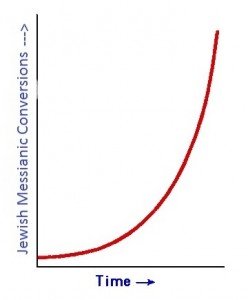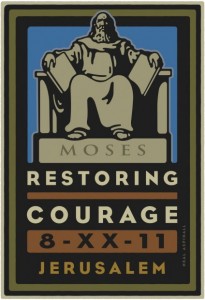By Cris D. Putnam
 In Vatican City, on October 10, 2010, Pope Benedict XVI opened the Synod of Bishops’ Special Assembly for the Middle East at St. Peter’s Basilica. The synod took place at the Vatican from Oct. 10–24 under the theme: “The Catholic Church in the Middle East: Communion and Witness.” Speaking as the alleged Vicar of Christ, the pontifex maximus said the Promised Land is “not of this world” and that Israel is not an earthly kingdom. His words are not surprising as the Roman Catholic Church has historically led the way in promoting supercessionism (replacement theology) by denying ethnic Israel’s place in God’s plan. According to the pope’s biblical eisegesis, “He reveals Himself as the God of Abraham, Isaac and Jacob (cf. Ex 3:6), who wants to lead his people to the ‘land’ of freedom and peace. This ‘land’ is not of this world; the whole of the divine plan goes beyond history, but the Lord wants to build it with men, for men and in men, beginning with the coordinates of space and time in which they live and which He Himself gave them.”[1]
In Vatican City, on October 10, 2010, Pope Benedict XVI opened the Synod of Bishops’ Special Assembly for the Middle East at St. Peter’s Basilica. The synod took place at the Vatican from Oct. 10–24 under the theme: “The Catholic Church in the Middle East: Communion and Witness.” Speaking as the alleged Vicar of Christ, the pontifex maximus said the Promised Land is “not of this world” and that Israel is not an earthly kingdom. His words are not surprising as the Roman Catholic Church has historically led the way in promoting supercessionism (replacement theology) by denying ethnic Israel’s place in God’s plan. According to the pope’s biblical eisegesis, “He reveals Himself as the God of Abraham, Isaac and Jacob (cf. Ex 3:6), who wants to lead his people to the ‘land’ of freedom and peace. This ‘land’ is not of this world; the whole of the divine plan goes beyond history, but the Lord wants to build it with men, for men and in men, beginning with the coordinates of space and time in which they live and which He Himself gave them.”[1]
While it is true that God’s plan ultimately transcends time and space, it simply cannot be denied that the Lord meant a literal land in His promises to the patriarchs. However, the pope is not so naïve; rather, he is promoting an agenda by painting the Promised Land as a metaphysical abstraction. His political and theological overtones reflect the Vatican’s consistent position that “Jerusalem cannot belong to one state.”[2] Rome ostensibly pleads the case of Palestinians and Catholics who want to make pilgrimage but in truth, there is a wealth of evidence that the Vatican wants to possess Jerusalem as its own
Furthermore, the pope’s homily is harbinger of the coming tribulation or “time of Jacob’s trouble” (Jer. 30:7). Like Paul in Romans 11:25, Jesus also said that Jerusalem would be occupied by gentiles until the times of the gentiles are fulfilled, just prior to His Second Coming.
“And they shall fall by the edge of the sword, and shall be led away captive into all nations: and Jerusalem shall be trodden down of the Gentiles, until the times of the Gentiles be fulfilled” (Lk 21:24).
Several important points can be derived from this statement by Jesus. First, it is a prophecy of the diaspora, which occurred in AD 70. The Romans spread the Jews all over the known world, selling many as slaves. Jesus’ prophecy could have been easily falsified but its fulfillment is verifiable. Second, the text uses the Greek term achri, rendered “until,” that clearly implies one day Jerusalem will be back in Jewish hands.[3] Thus, it is also an inferred prophecy about the reclamation of Jerusalem which began in 1967 and is still being contested by the Vatican. Jerusalem certainly was under Gentile control until 1967, and today it is the most fiercely contested piece of real estate on the planet. This should give skeptics pause because there are existing copies of Luke’s Gospel dated to the second century.[4] The fact that Jerusalem is ostensibly in Jewish hands speaks to the lateness of the hour in God’s prophetic plan. Recognizing the end-time markers “the fullness of the gentiles” (Ro 11:25) and “times of the Gentiles” (Lk 21:24) which were qualified by “until,” we now examine the current state of affairs to if they are lining up with the predicted arrival of Petrus Romanus.
One way to examine that “until” is in reference to Romans 11:25 and the spread of the Gospel and there are many competent sites like the The Joshua Project doing that.[5] One rather astonishing indicator is the success of the Gospel in China where it is reported that there are currently sixteen thousand, five hundred new converts per day![6] Africa reports similar numbers where sixteen thousand Muslims leave Islam per day for Christianity.[7] (While these numbers are exciting, there are still many unreached people-groups and languages with no Bible translation. To that end, we strongly encourage Christians to support missions.)
Still yet, another way to quantify that “until” might be to look at Israel and see if there is any movement in that sector. There were no more than a dozen or so Messianic believers in the Jewish homeland when they declared statehood in 1948 and only around 250 when they retook Jerusalem in 1967. Writing in the year 2000, Brent Kinman reported that, “Now there are in the neighborhood of six thousand believers in more than fifty congregations.”[8] Has this trend continued? As of May 26, 2011 The Baptist Press reported:
“Now there are an estimated 150 Jewish congregations around Israel meeting in different languages. The number of believers is estimated to be around 20,000, growing exponentially from 1948 when 12 Jews who believed in Jesus could be counted, to 1987 when there were 3,000 and 1997 where there were 5,000.”[9]
If you know anything about exponential growth then this strongly implies an event horizon when the line goes vertical, meaning that  the time of national repentance and recognition is close-at-hand. The Old Testament contains a vivid prophecy of that eventuality, “And I will pour upon the house of David, and upon the inhabitants of Jerusalem, the spirit of grace and of supplications: and they shall look upon me whom they have pierced, and they shall mourn for him, as one mourneth for his only son, and shall be in bitterness for him, as one that is in bitterness for his firstborn” (Zec 12:10). The Hebrew term, dāqar, which is rendered “pierced,” is derivative of madqārâ which appears ten times in various forms and always denotes a puncture wound. The Theological Wordbook of the Old Testament states, “The weapon associated with dāqar is usually the sword, though a spear is the instrument in Num 25:8.”[10] So according to the Hebrew prophet Zechariah, God was pierced and only Jesus Christ meets that characteristic. Tensions in the Middle East seem to forecast this prophesied national repentance sooner rather than later.
the time of national repentance and recognition is close-at-hand. The Old Testament contains a vivid prophecy of that eventuality, “And I will pour upon the house of David, and upon the inhabitants of Jerusalem, the spirit of grace and of supplications: and they shall look upon me whom they have pierced, and they shall mourn for him, as one mourneth for his only son, and shall be in bitterness for him, as one that is in bitterness for his firstborn” (Zec 12:10). The Hebrew term, dāqar, which is rendered “pierced,” is derivative of madqārâ which appears ten times in various forms and always denotes a puncture wound. The Theological Wordbook of the Old Testament states, “The weapon associated with dāqar is usually the sword, though a spear is the instrument in Num 25:8.”[10] So according to the Hebrew prophet Zechariah, God was pierced and only Jesus Christ meets that characteristic. Tensions in the Middle East seem to forecast this prophesied national repentance sooner rather than later.
Next week: The Vatican’s Designs on Jerusalem
[1] Robert Moynihan, “The Vatican Synod on the Middle East Begins,” Spero News, October 10, 2010, http://www.speroforum.com/a/41366/The-Vatican-Synod-on-the-Middle-East-begins.
[2] Chiara Santomiero, “Prelate: Jerusalem Can’t Belong to Just One State,” Zenit: The World Seen from Rome, October 12, 2012, http://www.zenit.org/article-30628?l=english.
[3] James Swanson, Dictionary of Biblical Languages With Semantic Domains: Greek (New Testament), electronic ed. (Oak Harbor: Logos Research Systems, Inc., 1997), 948 ἄχρι.
[4] P4 is likely the earliest existing copy of Luke’s Gospel but his silence on the fall of Jerusalem in AD 70 leads most to conclude it was written prior: see http://en.wikipedia.org/wiki/Papyrus_4.
[6] “Fastest-Growing Christian Population,” Worldmag, last accessed February 10, 2012, http://www.worldmag.com/articles/13748 .
[7] Ali Sina,“Islam in Fast Demise: In Africa Alone Everyday, 16,000 Muslims Leave Islam,” last accessed February 10, 2012, http://www.faithfreedom.org/oped/sina31103.htm.
[8] Brent Kinman, History, Design, and the End of Time: God’s Plan for the World (Nashville, TN: Broadman & Holman Pub, 2000), 71.
[9] Ava Thomas, “Among Israeli Jews, 20,000 Embrace Christ,” Baptist Press, May 26, 2011, http://www.sbcbaptistpress.org/BPnews.asp?ID=35389 .
[10] Robert Laird Harris, Gleason Leonard Archer, and Bruce K. Waltke, Theological Wordbook of the Old Testament, electronic ed. (Chicago: Moody Press, 1999, c1980), 195.





